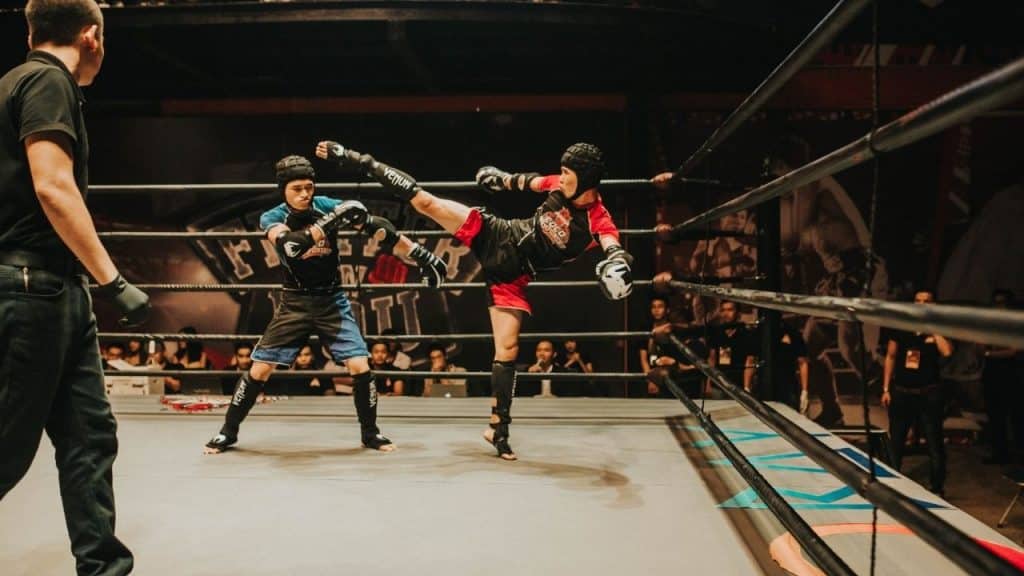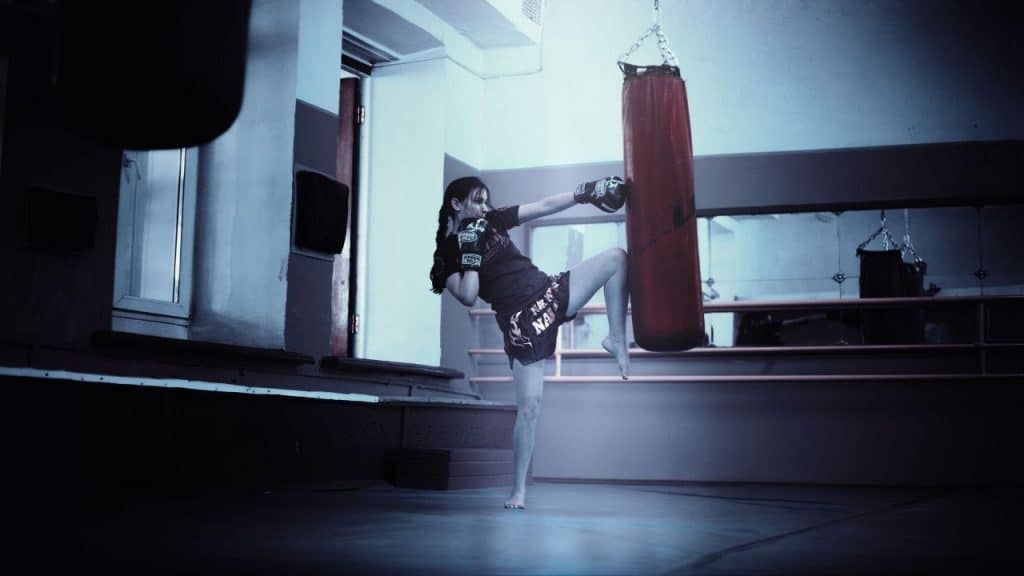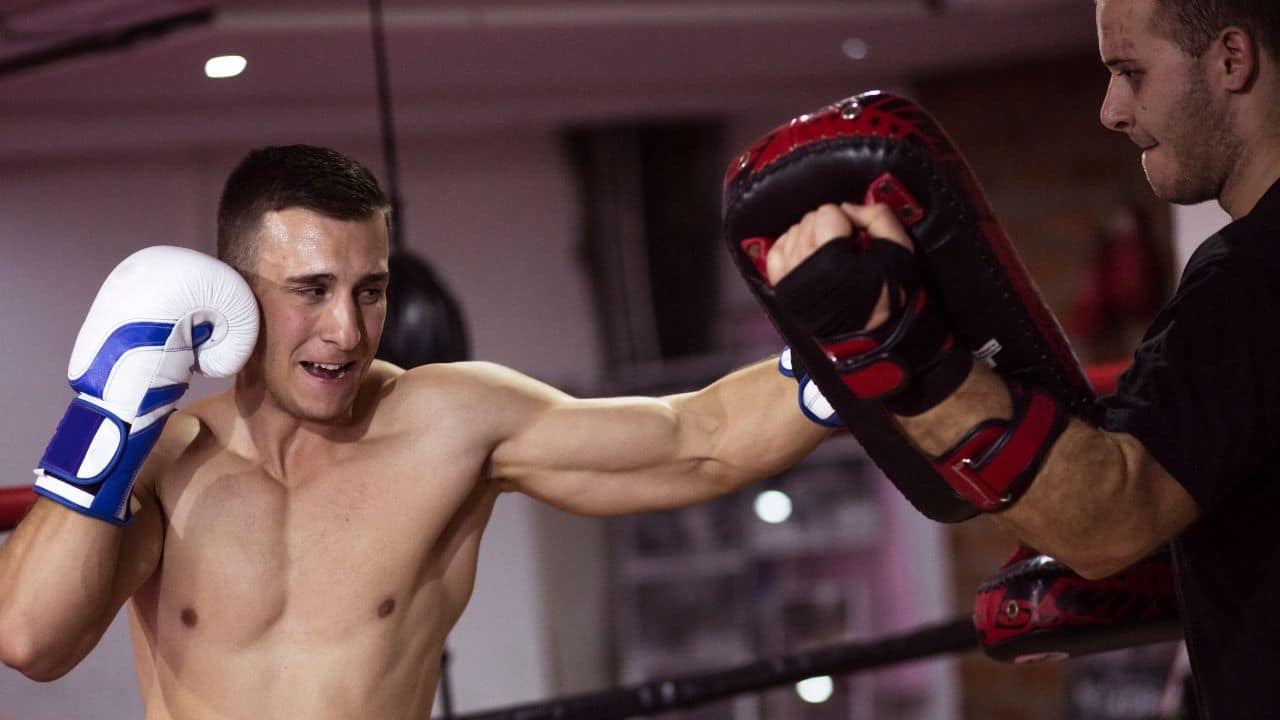The first MMA fights were style vs style matchups and didn’t last for long, but as the sport evolved, fighters developed and introduced new techniques.
Jon Jones is known as the first fighter to effectively use oblique kicks in MMA. His UFC 135 light heavyweight title match against Rampage Jackson was an outstanding piece of art because Jones was disrupting Jackson’s clinching and wrestling attempts with brutal left oblique kicks to the knee.
Since that day, dozens of UFC fighters have used oblique kicks in MMA, with some bouts ending with shocking knee injuries.
In this article, we will discuss oblique kicks and if they should be used in MMA fights.
What Is An Oblique Kick?
Technically, an oblique kick is somewhere in between a push kick and a Wing Chun technique called a “knee stomp”.
Yes, oblique kicks look very similar to a stomp, but there is a significant difference in strike direction, angle, and execution.
Here is a detailed explanation, step-by-step:
- The Wing Chun version is performed at a closer distance, while MMA oblique kicks are a long-range strike.
- The Wing Chun strike is designed for self-defense.
- Wing Chun insists on tilting your head forward (decreasing the distance between you and the opponent), while an MMA modification focuses on tilting your head backwards to evade the counter.
- The Wing Chun version mostly aims at the lateral side of the knee, while the MMA version focuses on the area above the kneecap.
Types Of Oblique Kicks
There are two types of oblique kicks – the lead leg and rear leg strike (right for orthodox fighter).
Also, there is an orthodox-to-orthodox stance blow and an orthodox-to-southpaw stance strike (or vice versa).
Technically, you can attack your opponent with oblique kicks in several possible ways.
Are Oblique Kicks Legal in MMA?
Oblique kicks are legal in most MMA promotions including the UFC, Bellator MMA, ONE FC and Cage Warriors.
In amateur and semi-pro bouts, you are not allowed to use oblique kicks. Although illegal, the referee will often not punish fighters if the oblique kick lands above the knee on the thigh.
Are Oblique Kicks Legal in Muay Thai & Kickboxing?

Kickboxing strictly prohibits oblique kicks, you can low kick above the level of the opponent’s knee and that’s it. If you perform an oblique kick, the referee will stop the fight and warn you verbally or deduct a point.
The Muay Thai rule book is kind of complicated as the paragraph says “kicks and knees are allowed to both legs (not the knees) of each fighter.” Ultimately, when you attempt an oblique kick to the thigh, it’s legal, but if it lands to the kneecap it’s illegal.
Oblique Kicks In The UFC
As already mentioned, Jon Jones can be called “the father of oblique kicks in MMA”. But his coach Mike Winkeljohn, an Albuquerque-born striking expert, was always interested in new techniques that took his fighters’ game to the next level.
The Wing Chun strike was modified for a UFC bout and Jon quickly became one of the most dangerous names in the division.
Technical Description of Jon Jones Oblique Kick
Jon Jones oblique kick is designed to stop the opponent’s progress and keep the distance (Jones’ reach is 84.5 inches, so he stays away from close-range exchanges for a reason).
When attempting a rear leg oblique kick, Jon Jones shifts his weight to his back foot and moves his head backwards to evade a big counter. It keeps him out of the range. Jones raises his foot to the level of the opponent’s thigh, then finishes the attack slightly above the level of the kneecap and returns it to the starting position.
Jones’ keeps his rear hand in the level of his chin when going for a rear oblique kick. He raises his front foot to the level of the opponent’s knee, slides few inches forward with his rear leg, rotating it around 120-degrees, hits the kneecap, tilts his head backwards, and leaves his front arm extended to prevent counterstrike punches.
Jones has never scored a stoppage with an oblique kick. He uses the technique to keep his opponents at a distance, helping him to win his fights.
Till Vs Whittaker Brutality
Another bout known for devastating oblique kicks is the match between Darren Till and Robert Whittaker in 2020. Till suffered a serious knee injury after receiving multiple knee stomps during the main event of UFC Fight Island 3.
The Most Violent Example
Modestas Bukauskas met Khalil Rountree in the main card of UFC Vegas 36. Khalil threw a lot of low kicks on his opponent’s left knee. When Bukauskas was pressed against the cage, Khalil slid forward and stopped him with a right oblique kick to the left (leading) leg.
Unfortunately, Modestas’ leg immediately overextended and Herb Dean waved off the contest. The Lithuanian fighter underwent surgery to repair an MCL injury that was sustained by the oblique kick.
Are Oblique Kicks Dangerous?

Oblique kicks are extremely dangerous.
They can cause the knee to overextend and resulting in a potential ligament injury. The areas most at risk are the ACL (anterior cruciate ligament), MCL (medial collateral ligament), and LCL (lateral collateral ligament).
Should Oblique Kicks Be Banned In MMA?
Khalil Rountree was heavily attacked on social media, but Modestas defended the stoppage with the sentence “it was my job to defend”. Dan Hardy is against banning oblique kicks alongside several other fighters including Joe Schilling, Jimi Manuwa and Kelvin Gastelum.
The MMA Rules Committee plans to evaluate the safety of this kick in their next meeting. Yet, there are no announcements of immediate rule change plans.
Should Oblique Kicks Be Illegal In MMA?
The oblique kick is one of the most dangerous ways to finish a fight in the world of martial arts. The technique can cause potential career-ending injuries and is one of the most gruesome ways to end a MMA fight.
Alongside the potential to end a fighter’s career, the technique can cost the MMA promotion a lot of money. Many elite-level fighters and industry experts are against oblique kicks for a reason.
What are your thoughts on this topic? Should the committee ban oblique kicks in MMA?


